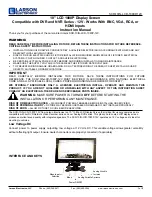
37
Important safety instructions
Adjusting Color
Highlight
Color
in the
Picture -- Basic
menu and adjust the values by pressing / on the projector
or remote control.
Lower setting produces less saturated colors; setting to the minimum value makes the image black and
white. If the setting is too high, colors on the image will be overpowering, which makes the image
unrealistic.
Adjusting Tint
Highlight
Tint
in the
Picture -- Basic
menu and adjust the values by pressing / on the projector or
remote control.
The higher the value, the more reddish the picture becomes. The lower the value, the more greenish the
picture becomes.
Adjusting Sharpness
Highlight
Sharpness
in the
Picture -- Basic
menu and
adjust the values by pressing / on the projector or
remote control.
The higher the value, the sharper the picture becomes. The
lower the value, the softer the picture becomes.
The
Brightness
,
Color
,
Contrast
,
Sharpness
, and
Tint
functions can also be accessible by pressing
BRIGHTNESS
,
COLOR
,
CONTRAST
,
SHARP
, and
TINT
on the remote control to display the
adjustment bar and then you can press / to adjust the values.
Adjusting Flesh Tone
This function adjusts accurate color primaries resulting in natural looking flesh tones with excellent color
saturation.
Highlight
Flesh Tone
in the
Picture -- Basic
menu and adjust the values by pressing / on the
projector or remote control.
The higher the value, the more reddish the flesh tones in the picture become. The lower the value, the
more greenish the flesh tones in the picture become.
Selecting a color temperature
*
Highlight
Color Temperature
in the
Picture -- Basic
menu or press
COLOR TEMP
on the remote
control to select a preferred setting by pressing / on the projector or remote control.
There are several color temperature settings available.
1.
Lamp Native:
With the lamp’s original color temperature and higher brightness. This setting is
suitable for environments where high brightness is required, such as projecting pictures in well lit
rooms.
2.
Warm:
Makes pictures appear reddish white.
3.
Normal:
Maintains normal colorings for white.
4.
Cool:
Makes pictures appear bluish white.
*About color temperatures:
There are many different shades that are considered to be "white" for various purposes. One of the common
methods of representing white color is known as the “color temperature”. A white color with a low color
temperature appears to be reddish white. A white color with a high color temperature appears to have more
blue in it.
0
1
2
















































